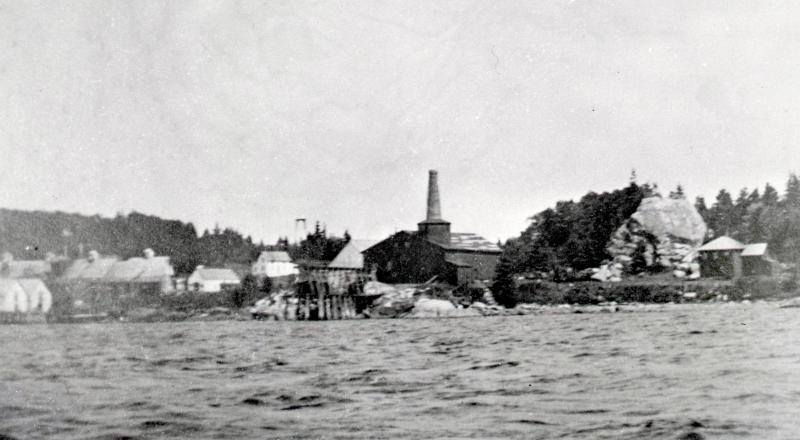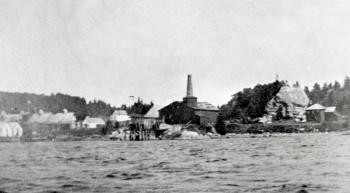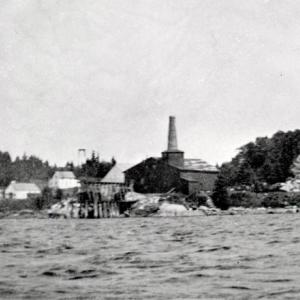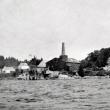The Upper Pogie Factory at Linekin, Part II
 This circa 1895 image is the only view of the Gallup & Holmes, later Church Hathaway, pogie factory near the Luke and Miller properties at Linekin. South of the wharf, factory, and most of the subsidiary buildings is Sunset Rock and the pyramid-roofed house I, my husband, and children lived in. The roof was altered after a fire. Courtesy of the Boothbay Region Historical Society
This circa 1895 image is the only view of the Gallup & Holmes, later Church Hathaway, pogie factory near the Luke and Miller properties at Linekin. South of the wharf, factory, and most of the subsidiary buildings is Sunset Rock and the pyramid-roofed house I, my husband, and children lived in. The roof was altered after a fire. Courtesy of the Boothbay Region Historical Society
 This circa 1895 image is the only view of the Gallup & Holmes, later Church Hathaway, pogie factory near the Luke and Miller properties at Linekin. South of the wharf, factory, and most of the subsidiary buildings is Sunset Rock and the pyramid-roofed house I, my husband, and children lived in. The roof was altered after a fire. Courtesy of the Boothbay Region Historical Society
This circa 1895 image is the only view of the Gallup & Holmes, later Church Hathaway, pogie factory near the Luke and Miller properties at Linekin. South of the wharf, factory, and most of the subsidiary buildings is Sunset Rock and the pyramid-roofed house I, my husband, and children lived in. The roof was altered after a fire. Courtesy of the Boothbay Region Historical Society
Last time, I wrote that in 1985 my 8th-grade son set out to do a school paper on the pogie factory that had been on our Linekin property. Our house was west just below Thrill Hill and Sunset Rock, now lived in seasonally by Alan Miller and Pam Burke. The adjoining Paul Luke place was part of the factory grounds too. I explained that pogies were an oily, bony fish used for paint, lamp oil, and fertilizer and bait, and I summarized the factory process. One barrel of oil required 27 barrels of fish; there were 195 pounds of fish in a barrel.
Our factory had multiple buildings, including the brick processing plant which was 75 feet square by 50 feet high, with a 150-foot chimney. Also scattered around the property were buildings that stretched a quarter mile, including offices, the management house, dormitories, the cookhouse, drying sheds, and a barn. Our house was said to have been the management house. The processing plant could produce 4,000 gallons of oil a day. In the 1870s, they turned out up to 135,000 gallons of oil—just that one factory among 19 along Lincoln County's coast, mostly in Boothbay and on the Pemaquid penisinsula.
Factory Owners and the Bust
The complex was built in 1866 by Gallup & Holmes of Connecticut on a five-acre parcel obtained from Benjamin Reed. However the deeds for all or part of it flew around dizzyingly—there were at least 17 in the next 20 years, many to and from various Gallups and Holmeses. Just as large vessels were often funded with sales of fractions of their tonnage, such as 1/64th of a vessel, large factories were like small, contained traded stocks, promising similar payoffs but always with risk. The factory deeds were for shares sometimes as small as 7/128ths. My husband obtained an exhaustive post-1898 title report by Dave Soule Sr., and Asa Tupper gave me his title chain that his father Cyrus created from the 1850s to the 1890s. Register articles citing the upper factory owners do not always conform to the Soule and Tupper deed chains. I trust the lawyers.
The big threat some had foreseen for the pogie business came in 1878 and 1879 when the pogies did not return, though they could still be found at Cape Cod and below at times. The local vanishing act took away hundreds of jobs and the celebrated local prosperity. Many fishermen, desperate for bait, sailed to other states for it. By August 1880 the Register reported all the coal was sold from the facility and the idle factory complex itself sold in December (no deed) with Gallup kept on as superintendent.
Struggling to Survive
The intent was to diversify and somehow extract income from the huge investment. In 1884 the Gallups were finally out of it by its 1884 sale to Richardson, who was processing whales taken by Albert Murray in a fishing steamer. Simeon Van Horn (born 1875) recorded in his Linekin memories that boys often stopped by to look at the whales. He also wrote that as the steamers rounded Ocean Point, they blew their whistles to signal the amount of fish of whatever variety they had aboard, one toot for each 100 barrels. In 1886, the factory was processing mackerel scrap.
Finally the factory shut down for two years. The local wrecking commissioner, Billy Sawyer, bought the factory in 1887, spelling doom for the buildings and tangible assets. But the pogies came back before the demolition started in 1888, and Church & Hathaway of Rhode Island bought the factory. From then on the property was called "the Church factory" or "Church Hathaway," along with "the upper pogie factory" by old timers.
The Workforce and the End
Prentiss "Pete" Jones was most familiar with this Church period since, as a boy, he and his father Jainus worked there. He said the "oilworks" were manned by Portuguese Cape Verdean Brava Islands in his time (1910?), as many as 50 brought from Cape Cod by manager Frank Cottrell to supplement the local workforce. They were paid $30 a month. At other times, for instance in 1890 and 1904, 50 to 65 Virginian blacks were brought up to man it.
Local men were employed there in various capacities such as cooks and administrators, and perhaps as factory hands. Osgood Vannah was the manager for years, Jainus Jones was bookkeeper, Sylvester Boyd and Martin Dodge were cooks, and Simeon Van Horn wrote that his Uncle Charles worked and lived right at the factory.
In one 1889 month Church Hathaway produced 80,000 gallons of pogie oil, while the 1890s were tenuous, with the middle of the decade best. Things dwindled along, but finally on January 1, 1910 the Register reported Church Hathaway was sold and being torn down. On March 12, 1910 the Register news was that a schooner was loading its machinery for Long Island. The factory, an old landmark for more than 40 years "will be missed." In 1928 it was described as "a big square hole filled with water."
What of the pogie today? They're still overfished for bait and now pet food. Pogie help control algae growth in coastal waters, being filter feeders of phytoplankton, but with their numbers so low, some coastal areas are dead zones with algae overgrowth exacerbated by fertilizer runoff. Maybe the massive pogie deaths in the 1800s that made Boothbay and other places temporarily rich also brought red or brown tides. There seems always to be a price when populations are forced out of kilter.
Event Date
Address
United States

























